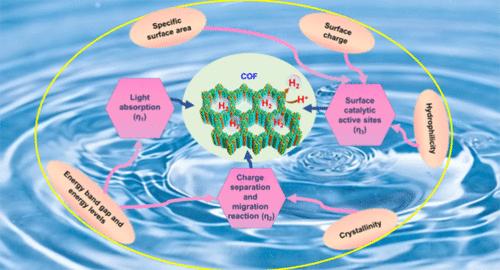揭示共价有机框架光催化制氢的结构-性能-活性相关性的关键因素
IF 13.1
1区 化学
Q1 CHEMISTRY, PHYSICAL
引用次数: 0
摘要
清楚地阐明各种结构特征及其相互作用如何影响光催化制氢性能一直是一项具有挑战性的任务。在这项工作中,我们利用结晶度、与形貌相关的比表面积、能带间隙和能级、表面电荷和亲水性等各种因素,研究了用于光催化制氢的β-酮烯胺键合价有机框架(TpPa-1-COF)的结构-性能-活性相关性,这些因素可能会影响光收集、电荷分离和转移以及表面催化活性位点。通过使用不同的方法制备 TpPa-1-COF ,我们可以调节这些影响因素,研究它们与活性的关系。研究发现,与以醋酸(HOAc)为催化剂(TpPa-1 (ST-HOAc))和以 KOH 溶液为催化剂(TpPa-1 (ST-KOH))的溶热法制备的 TpPa-1-COF 样品相比,分子组织法制备的 TpPa-1-COF (标记为 TpPa-1 (MO))具有最高的光催化 H2 演化活性、这与 TpPa-1 (MO) 的最高结晶度、最佳能级、最大 BET 比表面积和最佳亲水性有关。此外,我们的研究结果表明,TpPa-1 (MO) 光催化 H2 进化总效率(ηtotal)的提高可能主要归因于光生电荷(η2)的有效分离和迁移以及表面催化活性位点(η3)的活跃。总之,这项研究深入揭示了 TpPa-1-COF 光催化剂的结构-性质-活性关系,为深入设计基于 COF 的 H2 演化光催化剂提供了宝贵的启发和指导。本文章由计算机程序翻译,如有差异,请以英文原文为准。

Unraveling the Key Factors on Structure–Property–Activity Correlations for Photocatalytic Hydrogen Production of Covalent Organic Frameworks
It has been a challenging task to clearly elucidate various structural features and how their interactions affect the photocatalytic hydrogen production performance. In this work, various factors, including crystallinity, specific surface area associated with morphology, energy band gap and energy levels, surface charge, and hydrophilicity, were employed to investigate the structure–property–activity correlations of β-ketoenamine-linked covalent organic framework (TpPa-1-COF) for photocatalytic H2 production, which could influence the light harvesting, charge separation and transfer, and surface catalytic active sites. By using different methods to prepare TpPa-1-COFs, we can regulate these influencing factors to investigate their relationship with activity. It is found that the TpPa-1-COF prepared by a molecular organization method (labeled as TpPa-1 (MO)) exhibits the highest photocatalytic H2 evolution activity compared with the TpPa-1-COF samples prepared by solvothermal methods using acetic acid (HOAc) as a catalyst (TpPa-1 (ST-HOAc)) and KOH solution as a catalyst (TpPa-1 (ST-KOH)), which is associated with the highest crystallinity, the optimal energy levels, the largest BET-specific surface area, and the best hydrophilicity for TpPa-1 (MO). Moreover, our findings suggest that the enhanced total photocatalytic H2 evolution efficiency (ηtotal) of TpPa-1 (MO) may be mainly attributed to the efficient separation and migration of photogenerated charges (η2) and the vibrant surface catalytic active sites (η3). Overall, this work provides some deep insights into the structure–property–activity relation of TpPa-1-COF photocatalysts, which offers valuable inspiration and guidance for the thoughtful design of COF-based photocatalysts for H2 evolution.
求助全文
通过发布文献求助,成功后即可免费获取论文全文。
去求助
来源期刊

ACS Catalysis
CHEMISTRY, PHYSICAL-
CiteScore
20.80
自引率
6.20%
发文量
1253
审稿时长
1.5 months
期刊介绍:
ACS Catalysis is an esteemed journal that publishes original research in the fields of heterogeneous catalysis, molecular catalysis, and biocatalysis. It offers broad coverage across diverse areas such as life sciences, organometallics and synthesis, photochemistry and electrochemistry, drug discovery and synthesis, materials science, environmental protection, polymer discovery and synthesis, and energy and fuels.
The scope of the journal is to showcase innovative work in various aspects of catalysis. This includes new reactions and novel synthetic approaches utilizing known catalysts, the discovery or modification of new catalysts, elucidation of catalytic mechanisms through cutting-edge investigations, practical enhancements of existing processes, as well as conceptual advances in the field. Contributions to ACS Catalysis can encompass both experimental and theoretical research focused on catalytic molecules, macromolecules, and materials that exhibit catalytic turnover.
 求助内容:
求助内容: 应助结果提醒方式:
应助结果提醒方式:


